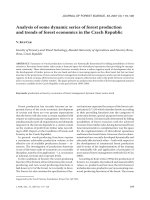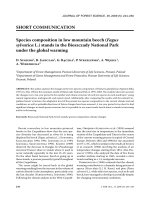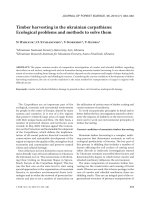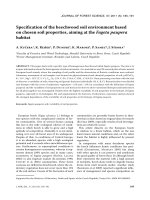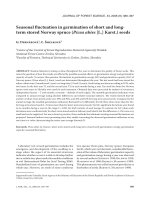Báo cáo lâm nghiệp: "Timber harvesting in the ukrainian carpathians: Ecological problems and methods to solve them" ppsx
Bạn đang xem bản rút gọn của tài liệu. Xem và tải ngay bản đầy đủ của tài liệu tại đây (1.02 MB, 8 trang )
J. FOR. SCI., 56, 2010 (7): 333–340 333
JOURNAL OF FOREST SCIENCE, 56, 2010 (7): 333–340
The Carpathians are an important part of the
ecological, economic and recreational environment
for people in the centre of Europe, shared by many
nations and countries. It is one of a few regions
that preserve relatively large areas of virgin forests
with their unique fauna and flora. On their basis, a
number of protected objects and territories were
created. In May 2003, Ukraine signed e Conven-
tion on the Protection and Sustainable Development
of the Carpathians, which defines the implemen-
tation of all-round policies directed towards the
conservation and sustainable development of the
region to improve the quality of life, strengthen local
economies and communities and preserve natural
values and cultural heritage.
One of the laws in force directed to more environ-
ment-friendly ways of forest utilization in Ukraine is
the Ukrainian Act on “e moratorium on Perform-
ing Clear Cutting on Mountain Slopes in Spruce-
Beech Forests of the Carpathian Region”. is law
was the first one on the state level to start using
special approaches to the organization of mountain
forestry, to introduce environmental forest tech-
nologies and to widen the network of protected ter-
ritories and also to set a number of restrictions on
the utilization of certain ways of timber cutting and
certain systems of machinery.
To work out particular principles in detail and to
better define the law, investigations started to deter-
mine the impacts of skidders on the forest environ-
ment and to work out environmental principles of
timber harvesting.
Current condition of mountain timber harvesting
Mountain timber harvesting is a complex, multi-
step process that determines economic as well as
ecological productivity of forestry. e key part of
this process is skidding that includes a number of
factors affecting the soil surface of cutting areas
either directly or indirectly. Investigations started
by Ukrainian scientists unravelled these factors and
determined the degree to which forest crawler and
wheeled machinery influences the environment.
e main components of mountain timber har-
vesting are the construction and running of forest
roads. If horses are used, this is horse portage, in the
case of crawler and wheeled machinery, these are
skidding tracks. ey are an integral part of the or-
ganizational structure of primary transportation of
Timber harvesting in the ukrainian carpathians:
Ecological problems and methods to solve them
N. B
, O. S
, V. K
, V. K
1
Ukrainian National Forestry University, Lviv, Ukraine
2
Ukrainian Research Institute for Mountain Forestry, Ivano-Frankivsk, Ukraine
ABSTRACT: e paper contains results of comparative investigations of crawler and wheeled skidders regarding
their effect on soil surface, undergrowth and rut formation during mountain timber harvesting. It was shown that the
extent of erosion resulting from damage to the soil surface depends on the steepness and length of slopes during both
construction of skidding tracks and skidding by tractors. Considering the current condition of development of timber
harvesting machinery, the use of crawler machines is the main method for transportation of cargos in regions with
difficult access.
Keywords: crawler and wheeled skidders; damage to ground surface; rut formation; undergrowth damage
334 J. FOR. SCI., 56, 2010 (7): 333–340
timber; thus, their optimal distribution determines
the ecological efficiency of technology of exploita-
tion of the cutting area.
It was stated (B et al. 2002) that tractor
skidding is the most harmful for the soil surface,
especially during the construction of skidding tracks
by a bulldozer. For example, in the mountains, if
the area of skidding tracks is 8% of the total cutting
area, the volume of soil damaged by erosion often
amounts to 500 m
3
ha
–1
. Erosion on skidding tracks
may reach up to 70% of its total volume on the cut-
ting area. e volume of soil erosion inflicted by
forest machinery is a function of the steepness and
length of a slope, degree of soil erosion vulnerability
(which in general depends on the presence of small-
size particles in soil); fraction of the area covered
by vegetation; intensity, duration, extension and
frequency of precipitation.
e intensity of natural renewal of the cutting
area surface on mountain slopes and its consequent
condition significantly differ from conditions on
plains, thus, from ecological positions it is especially
important to take measures to preserve the existing
undergrowth during timber harvesting. e use of
cableway skidding system ensures the preservation
of viable undergrowth under forest floor and allows
solving the problem of reforestation on steep slopes.
e data obtained in the North Caucasus by Rus-
sian scientists (P 1977) shows that in
some cases it is possible to save 80–90% of existing
undergrowth, which is 1.5–2 times more than during
primary transportation of timber by skidders. Be-
sides objective factors, a significant influence on the
environment is caused by a human factor. e cases
of violation of timber harvesting technology during
cutting are not scarce. e location of undergrowth
is not always taken into account; the regulated width
of cutting, main and strip skidding tracks is not ob-
served. is is caused by the absence of responsibil-
ity for violation of the ecological balance of forest
ecosystems and damage inflicted to environment.
In other countries, investigations on this problem
have already been carried out for many years and
economic stimuli to environmental forest utilization
on steep slopes have been introduced.
e transport network plays an important role
in the forest industry production of mountain re-
gions where forest areas are scattered in vast ter-
ritories and are characterized by complex relief,
soil-hydrological features, low concentration of
harvested timber per unit area, one-sidedness of
freight traffic volume and other factors. Forest roads
play an important role not only in forest utilization,
renewal and preservation, but also in the general
development of a region, its recreational potential,
improving working conditions and well-being of the
population. In European countries with developed
forest industry, the construction of forest roads is
subsidized as a part of the state transport network.
Costs of the construction and maintenance of forest
roads constitute there nearly one third of the total
cost of harvested timber.
In the Carpathian region of Ukraine, the network
of forest roads is not fully developed; its density is
4–7 times lower than in the countries of West and
Central Europe. Forest areas with the density of
roads more than 10 mha
–1
constitute less than 2%
of the total forest area. More than 40% of forest ter-
ritories have the road density lower than 0.4 mha
–1
(Fig. 1). is state of the transport network leads to
wide utilization of primary trails of timber trans-
portation in forest expanses, i.e. skidding tracks,
which are basic passages established without us-
ing engineering structures and drainage and have
rather large longitudinal inclines, which in most
cases does not allow using them for the passage
of wheeled machinery skidders and tractors with
cable systems. e problem of selection of a type of
0
5
10
15
20
25
30
35
40
45
0–0.2 0.2–0.4 0.4–0.6 0.6–0.8 0.8–1.0 1.0–1.2
Forest road network density (m·ha
–1
)
(%)
Fig. 1. Distribution of the forest areas of the
Carpathian region by presence of roads
J. FOR. SCI., 56, 2010 (7): 333–340 335
skidder, in particular, determination of advantages
of wheeled vs. crawler driving unit is urgent not
only for the mountain regions of Ukraine. Table 1
summarizes results of the comparative investigation
(M et al. 2003) of damage intensity to the
soil surface and rootage by forest machinery with
different types of driving units on mountain slopes
of West Europe.
For all conditions of exploitation crawler machin-
ery has clear advantages regarding the degree of
damage to the soil surface. But on the other hand,
wheeled machinery has an obvious advantage in
minimizing the effect on rootage. For forests on
plains and slopes of medium steepness there is no
single recommendation.
However, the final decision on the choice of a
skidder with either wheeled or crawler driving unit
should be based on detailed analysis of physical-
mechanical features of soil, predicted number of
passages, specific pressure of forest machine on soil
and weather conditions.
MATERIAL AND METHODS
e effect of wheeled and crawler skidders on for-
est environment was evaluated by investigating the
damage to undergrowth and soil surface caused by
timber skidding and also by investigating the proc-
esses of rut formation.
For the first type of investigation, research-indus-
trial plots were chosen in the mountain zones of
forest resources of five state enterprises. e plots
were characterized by different natural-industrial
conditions, which allowed getting real indices of the
effect of different types of transport on the forest.
The investigation of undergrowth damage was
performed on three transects located on a slope in
different sites of the cutting area, i.e. in its lower,
medium and upper part (far-off end of the cutting
area) while 15–25 plots (depending on particular
conditions, e.g. mosaics of renewal), 2 × 2 m each,
were established on each transect.
e main parameters characterizing the effect of
timber harvesting technology on the young gen-
eration of forest are its quantitative and qualitative
condition after timber cutting (M 1966;
P et al. 1988; K 2005). e quantity of
undergrowth on a cutting area was determined by
counting it on experimental plots and relating it to
the area of 1 ha. Qualitatively, undergrowth on a
cutting area was divided into the following catego-
ries: undamaged, weakly or greatly damaged and
destructed.
e effect of harvesting operations on the soil
surface of cutting area was assessed complexly by
investigation of the degree of damage to soil dur-
ing harvesting operations and determination of
plane and volumetric parameters of skidding tracks
(P 1965; O 1998). e degree of
damage to soil was divided into the following cat-
egories:
Zero category: ere is no damage, the soil surface
is not disturbed. It includes areas which were not
disturbed by harvesting operations and preserve the
forest floor.
First category: e forest floor is loosened be-
cause of the fall of trees or moving their crowns. e
soil is not damaged.
Second category: ere are plots with forest floor
removed by harvesting operations, but still preserv-
ing the humus horizon. e damage is mainly plain
and local.
ird category: ere are plots with linear dam-
age in the form of primary skidding tracks (made
by one trunk). It includes single and multiple pas-
sages of a tractor to the plots outside of the skidding
tracks.
Fourth category: ere is linear-plane damage in
the form of secondary skidding tracks (damage made
by several trunks) and horse and tractor skidding
tracks. e third and the forth category of damage
to soil is subdivided into three categories by their
depth: under 5 cm, 6–10 cm and above 10 cm.
Fifth category: ere are deposits, containing
small fractions of soil, leaves and stones, which are
created during skidding.
Field investigations of rut formation by the traffic
of wheeled and crawler tractors on forest soils were
Table 1. Recommendations for utilization of wheeled and crawler forest machinery on surface with different inclines
Surface
incline
Best results from the point of damage minimization
Recommendation
for usage
soil surface rootage
~ 0° crawler harvester and wheeled or crawler forwarder wheeled machinery wheeled machinery
< 17° crawler machinery wheeled machinery wheeled machinery
> 17° crawler machinery crawler machinery crawler machinery
336 J. FOR. SCI., 56, 2010 (7): 333–340
performed on specially selected plots in the forest.
e main factors determining the effect of a driving
unit on soil are density of soil in the rut and its depth,
which depend on the number of passages in the same
track. Investigations included measuring the depth
of ruts, degree of damage to the bearing surface and
soil sampling.
Before the beginning of investigations the radius of
turns, lengths of linear plots, weight and geometrical
parameters of a tractor were determined. Samples of
the undamaged layer of soil were taken on each plot
and at least four measuring points were established
at the distance of 1 m from each other.
e following parameters were determined: soil
moisture (by weight), physical density of soil, modu-
lus of deformation, density by the difficulty of culti-
vation and depth of ruts. Based on the obtained data,
plots of dependence of distribution of soil density in
the rut from the number of passages were built.
RESULTS
Undergrowth damage
Investigations were performed during a snowless
period on 56 experimental plots. For crawler trac-
tors, the largest portion of cutting areas (41%) had
slopes of 15–20° and for wheeled tractors the most
common (34%) were plots with slopes of 10–15°.
The obtained results of investigations (Fig. 2)
demonstrate that using crawler tractors for timber
harvesting preserves on average 85.1% of under-
growth and using wheeled tractors preserves 84.4%
of undergrowth. is percentage depends on many
factors, including the season of harvesting, steep-
ness of slope, position of skidding tracks etc., and
varies between 50.0% and 99.5%. By the portion of
undamaged undergrowth we mean the degree of
its preservation on areas undisturbed by skidding
tracks. But practically all undergrowth is destroyed
on the skidding tracks because they are prepared
before cutting. us, it can be considered that the
portion of a plot occupied by skidding tracks is free
of undergrowth and after timber harvesting it should
be a subject for reforestation.
ere is no significant difference in the degree of
damage caused by crawler and wheeled tractors be-
cause these forest machines perform identical opera-
tions during timber collection and skidding.
e intensity of undergrowth damage by skidders
by categories is shown in Table 2. For both types of
tractors the prevalent types of damage are peeling of
trunks (46.2% and 57.1%) and weak or strong damage
to rootage (19.1% and 23.1%) that is caused by the
movement of trunks or tractors.
5
6.4
3.5
2.9
6.8
2.9
0
1
2
3
4
5
6
7
8
Weakly
damaged
Greatly
damaged
Destructed
(%)
Crawler
skidder
Wheeled
skidder
Fig. 2. Distribution of undergrowth damage by categories
Table 2. Average numbers of damaged undergrowth – Type and magnitude of damage, thousands per 1 ha (%)
Crown damage Fracture of top Peeling of bark Fracture of trunk Roots damage
Skidding by crawler tractors
0.2 (9.5) 0.1 (4.8) 1.2 (57.1) 0.2 (9.5) 0.4 (19.1)
Skidding by wheeled tractors
0.2 (7.7) 0.3 (11.5) 1.2 (46.2) 0.3 (11.5) 0.6 (23.1)
Table 3. Average characteristics of skidding ways on research plots
Type of skidder
Length of skidding
ways (mha
–1
)
Average
width (m)
Area
(m
3
ha
–1
)
% of cutting
area
Soil erosion volume on
skidding ways (m
3
ha
–1
)
Crawler tractors 108 5.0 522 5.2 220
Wheeled tractors 118 4.5 508 5.1 169
J. FOR. SCI., 56, 2010 (7): 333–340 337
Damage to soil surface
During the investigation of damage to the soil
surface of mountain cutting area, the main features
(extent, average width, area and volume of opera-
tional erosion) of skidding tracks used for the traffic
of wheeled and crawler machinery were determined
(Table 3). eir analysis suggests that the density
of skidding track network and portion of the area
they occupy in cutting areas developed by wheeled
tractors is almost 10% larger than in cutting area de-
veloped by crawler tractors. is is explained by the
existing limitations of slopes where wheeled tractors
can be used and related necessity of laying a greater
number of skidding tracks.
On average, on the investigated cutting areas, skid-
ding tracks take up 5.2% of cutting area if crawler
tractors are used, and 5.1% if wheeled tractors are
used, which is basically the same number. e vol-
umes of soil erosion caused by skidding tracks are
220 and 169 m
3
ha
–1
, respectively.
In the case of tractor skidding, around 80% of the
cutting area is left undamaged; the difference between
wheeled and crawler tractors does not exceed 0.5%.
e plots with mineralized surface, i.e. those where
the forest floor is partly mixed with mineral particles of
soil, constitute 9.3% of the total cutting area if crawler
tractors are used, which is 1.5 times more than for
wheeled tractors. But from the forestry point of view,
mineralized plots play a positive role because they as-
sist in the natural renewal of forests, especially in the
case of unclear cutting. e average volume of soil
erosion, taking into account skidding tracks and areas
outside of skidding tracks is 264 m
3
ha
–1
if crawler
tractors are used and 240 m
3
ha
–1
if wheeled tractors
are used. e difference is in the range of 10%.
Comparative data on damage to the soil surface on
a cutting area where wheeled and crawler tractors are
used is shown in Fig. 3.
Intensity of rut formation
Features of plots used as the proving ground for the
investigation of rut formation are shown in Table 4.
Results of the investigation and photographs of indi-
vidual stages of measuring are shown in Figs. 4–6.
Analysis of the obtained graphical dependences
allowed drawing the following conclusions:
– e intensity of rut formation significantly de
-
pends on the bearing capacity of soil, which is
9.3
2.5
2
6.3
1.1
6.3
3
3.2
6.8
1.7
0
1
2
3
4
5
6
7
8
9
10
Mineralized Damage less
than 5 cm
Damage 6–10
cm
Damage more
than 10 cm
Deposits
(%) of the area
Crawler
skidder
Wheeled
skidder
Fig. 3. Comparative data on the soil surface
damage
Table 4. Characteristics of test plots
Plot No.
Object of investigation;
load
Description and transversal incline
of the area
Primary parameters of soil
density (gcm
–3
) humidity (%)
1 LKT-81
covered by dense vegetation, 9°
0.65–0.99 70–81
2 TDT-55А 1.00–1.37 43–73
3 ТТ-4; 1 (t)
frozen soil with broken stone, compressed
by branches, 0°
1.30–1.55 43–55
4 LKT-81; 0.7 (t)
covered with dense vegetation, well-
ventilated, 7°
0.71–1.08 42–51
5
TDT-55А; 1.56 (t)
well-moistened and compressed with
branches, 2°
1.18–1.49 32–61
TAF-657; 1.12 (t)
338 J. FOR. SCI., 56, 2010 (7): 333–340
y = 4.4483ln(x) –
0.5477
y = 2.57ln(x) –
0.6443
0
2
4
6
8
10
12
0 5 10 15
Rut depth (cm)
Passages
without branches
with branches
y = 1.900ln(x) + 0.344
y = 4.706ln(x) + 0.876
0
2
4
6
8
10
12
14
0 5 10 15
Rut depth (cm)
Passages
y = 0.108ln(x) + 1.327
y = 0.213ln(x) + 1.408
1.3
1.5
1.7
1.9
0 5 10 15
Density of soil (g·cm
–
3
)
Passages
Straight motion
turn with minimal radius
y = 4.4483ln(x) –
0.5477
y = 2.57ln(x) –
0.6443
0
2
4
6
8
10
12
0 5 10 15
Rut depth (cm)
Passages
without branches
with branches
y = 1.900ln(x) + 0.344
y = 4.706ln(x) + 0.876
0
2
4
6
8
10
12
14
0 5 10 15
Rut depth (cm)
Passages
y = 0.108ln(x) + 1.327
y = 0.213ln(x) + 1.408
1.3
1.5
1.7
1.9
0 5 10 15
Density of soil (g·cm
–
3
)
Passages
Straight motion
turn with minimal radius
Fig. 5. Investigation of the interaction of crawler skidder
TDT-55A with bearing surface (plot 2)
y = 4.4483ln(x) –
0.5477
y = 2.57ln(x) –
0.6443
0
2
4
6
8
10
12
0 5 10 15
Rut depth (cm)
Passages
without branches
with branches
y = 1.900ln(x) + 0.344
y = 4.706ln(x) + 0.876
0
2
4
6
8
10
12
14
0 5 10 15
Rut depth (cm)
Passages
y = 0.108ln(x) + 1.327
y = 0.213ln(x) + 1.408
1.3
1.5
1.7
1.9
0 5 10 15
Density of soil (g·cm
–
3
)
Passages
Straight motion
turn with minimal radius
Density of soil (g
.
cm
–3
)
y = 4.4483ln(x) –
0.5477
y = 2.57ln(x) –
0.6443
0
2
4
6
8
10
12
0 5 10 15
Rut depth (cm)
Passages
without branches
with branches
y = 1.900ln(x) + 0.344
y = 4.706ln(x) + 0.876
0
2
4
6
8
10
12
14
0 5 10 15
Rut depth (cm)
Passages
y = 0.108ln(x) + 1.327
y = 0.213ln(x) + 1.408
1.3
1.5
1.7
1.9
0 5 10 15
Density of soil (g·cm
–
3
)
Passages
Straight motion
turn with minimal radius
Straight motion
turn with minimal radius
y = 2.2275ln(x) –
0 8165
8
10
y = 4.5179ln(x) –
1.4316
15
20
0
.
8165
y = 0.985ln(x) + 0.511
0
2
4
6
0
10
20
30
40
50
Rut depth (cm)
y = 2.2275ln(x) –
0.8165
0
5
10
15
0
10
20
30
40
50
Rut depth (cm)
0
10
20
30
40
50
Passages
without branches
with branches
0
10
20
30
40
50
Passages
turn with a minimal radius
Straight motion
y = 0.247ln(x) + 0.636
1.4
1.6
(g·cm
–
y = 0.168ln(x) + 0.714
0.6
0.8
1.0
1.2
0 10 20 30 40 50
Density of soil
3
)
Passages
Passages
y = 2.2275ln(x) –
0 8165
8
10
y = 4.5179ln(x) –
1.4316
15
20
0
.
8165
y = 0.985ln(x) + 0.511
0
2
4
6
0
10
20
30
40
50
Rut depth (cm)
y = 2.2275ln(x) –
0.8165
0
5
10
15
0
10
20
30
40
50
Rut depth (cm)
0
10
20
30
40
50
Passages
without branches
with branches
0
10
20
30
40
50
Passages
turn with a minimal radius
Straight motion
y = 0.247ln(x) + 0.636
1.4
1.6
(g·cm
–
y = 0.168ln(x) + 0.714
0.6
0.8
1.0
1.2
0 10 20 30 40 50
Density of soil
3
)
Passages
Passages
Fig. 4. Investigation of the interaction of wheeled skidder
LKT-81 with bearing surface (plot 1)
y = 2.2275ln(x) –
0 8165
8
10
y = 4.5179ln(x) –
1.4316
15
20
0
.
8165
y = 0.985ln(x) + 0.511
0
2
4
6
0
10
20
30
40
50
Rut depth (cm)
y = 2.2275ln(x) –
0.8165
0
5
10
15
0
10
20
30
40
50
Rut depth (cm)
0
10
20
30
40
50
Passages
without branches
with branches
0
10
20
30
40
50
Passages
turn with a minimal radius
Straight motion
y = 0.247ln(x) + 0.636
1.4
1.6
(g·cm
–
y = 0.168ln(x) + 0.714
0.6
0.8
1.0
1.2
0 10 20 30 40 50
Density of soil
3
)
Passages
Passages
Density of soil (g
.
cm
–3
)
y = 4.5179ln(x) – 1.4316
y = 2.22751ln(x) – 0.8165
y = 4.4483ln(x) –
0.5477
y = 2.57ln(x) –
0.6443
0
2
4
6
8
10
12
0 5 10 15
Rut depth (cm)
Passages
without branches
with branches
y = 1.900ln(x) + 0.344
y = 4.706ln(x) + 0.876
0
2
4
6
8
10
12
14
0 5 10 15
Rut depth (cm)
Passages
y = 0.108ln(x) + 1.327
y = 0.213ln(x) + 1.408
1.3
1.5
1.7
1.9
0 5 10 15
Density of soil (g·cm
–
3
)
Passages
Straight motion
turn with minimal radius
turn with a minimal
radius
y = 2.22751ln(x) – 0.8165
y = 4.4483ln(x) –
0.5477
y = 2.57ln(x) –
0.6443
0
2
4
6
8
10
12
0 5 10 15
Rut depth (cm)
Passages
without branches
with branches
y = 1.900ln(x) + 0.344
y = 4.706ln(x) + 0.876
0
2
4
6
8
10
12
14
0 5 10 15
Rut depth (cm)
Passages
y = 0.108ln(x) + 1.327
y = 0.213ln(x) + 1.408
1.3
1.5
1.7
1.9
0 5 10 15
Density of soil (g·cm
–
3
)
Passages
Straight motion
turn with minimal radius
without branches
with branches
y = 2.571ln(x) – 0.6443
y = 4.4483ln(x) – 0.5477
y = 4.4483ln(x) –
0.5477
y = 2.57ln(x) –
0.6443
0
2
4
6
8
10
12
0 5 10 15
Rut depth (cm)
Passages
without branches
with branches
y = 1.900ln(x) + 0.344
y = 4.706ln(x) + 0.876
0
2
4
6
8
10
12
14
0 5 10 15
Rut depth (cm)
Passages
y = 0.108ln(x) + 1.327
y = 0.213ln(x) + 1.408
1.3
1.5
1.7
1.9
0 5 10 15
Density of soil (g·cm
–
3
)
Passages
Straight motion
turn with minimal radius
without branches
with branches
determined by the geomorphologic structure of
the Carpathians to a considerable extent.
– e most intense compression of soil occurs dur
-
ing the first several passages (around 70% of the
rut depth).
– e existence of a floor
of branches significantly
(2–3 times) decreases the depth of a rut and also
decreases the intensity of soil compression by
10–20%. A larger decrease in the degree of dam-
age is typical of the crawler driving unit.
J. FOR. SCI., 56, 2010 (7): 333–340 339
– At turns with minimal radius the depth of ruts
increases 1.5–2 times for wheeled tractor and
2–3 times for crawler tractor as compared with
linear movement.
– Soil compression by wheeled and crawler tractors
during linear movement occurs practically by the
same dependences.
– Greater damage to the soil surface with high bear
-
ing capacity is typical of crawler tractors while
wheeled tractors cause greater damage to the
surface with low bearing capacity.
CONCLUSIONS
e effect of technological processes and systems
of machines used in mountain forests on the forest
environment significantly depends on the way of
primary transportation of timber and transportation
network in forests.
e greatest damage to the forest environment
(soil, undergrowth, forest) is inflicted during soil
transportation of timber while using either crawler
or wheeled tractors moving by elementary passages
(skidding tracks). From this position, cut of length
timber harvesting has clear advantage. It includes
primary transportation of timber by forwarders and
thus eliminates the possibility of damage to the soil
surface by timber.
e highest volume of soil erosion (~70–80 %) is
inflicted by shifting the soil while establishing skid-
ding tracks which are the main cause of further ero-
sion after the end of timber harvesting operations.
e volume of erosion resulting from damage to
the soil surface during preliminary establishment of
skidding tracks as well as skidding by tractors sig-
nificantly depends on the steepness of a slope and
its length (the degree of erosion is approximately
proportional to double steepness of a slope in %).
e intensity of damage to the bearing surface
depends on parameters of soil in the rut of skidding
tracks, weather conditions during the works, number
of passages and specifics of the construction of a
skidder:
– With an increase in the number of passages the
degree of soil damage grows logarithmically;
– Soil compression leads to a decrease in its humid
-
ity and softness and an increase in density thick-
ness and shear strength;
– e damage to the bearing surface reversely de
-
pends on the degree of soil freezing;
– e presence of branch floor decreases the depth
of ruts, especially on soils with undamaged struc-
ture (2–4 times);
– Crawler and wheeled tractors on loamy soils
compress the bearing surface approximately to
the same extent.
There are practically no differences in under-
growth damage inflicted by crawler or wheeled trac-
tors because during timber collection and skidding
the extraction by these machines performs practi-
cally the same operations.
At the current stage of development of timber
harvesting machinery, the main method to solve
problems of cargo transportation in regions difficult
to access is the utilization of a system of machines
using the crawler driving unit.
Technological processes of timber harvesting have
to be based on the optimal combination of different
types of special forest machinery, depending on spe-
cific natural-industrial conditions, with obligatory
preliminary construction of forest roads and ensur-
ing the optimal distances of primary transportation
of timber.
One of the main methods to decrease the negative
influence of primary timber transportation is the uti-
lization of cable transport systems on steep slopes.
Fig. 6. Investigation of the interaction of wheeled TAF657 and crawler TT4 skidders with bearing surface (plot 5)
340 J. FOR. SCI., 56, 2010 (7): 333–340
R ef e re nc es
B N., S O., B M., B M.,
S A. (2002): Methodical approaches to the improve-
ment of technology of mountain harvesting taking into
account environmental requirements. Naukovyy visnyk
Natsionalnogo agrarnogo universytetu, 54: 128–137. (in
Ukrainian)
K V. S. (2005): To the method of estimation of success
of the forest renewal. In: Proceedings of International
Scientific Conference Scientific Bases of Sustainable Forest
Management. Ivano-Frankivsk: 157–160. (in Ukrainian)
M D., W B., K J., O G. (2003): Com-
parative study of the impact of wheeled and tracked forest
machines on soil and roots. In: Proceedings Austro 2003
– High Tech Forest Operations for Mountainous Terrain.
5.–9. October 2003. Schlaegl, Austria. University of Natural
Resources and Applied Sciences Vienna. CD-ROM: 1–8.
M P. I. (1966): e beech forests and management of
them. Moskva, Lesnaya promyshlennost: 123. (in Russian)
P V. I., M G. M., O V. S., O-
A . S., K V. S. (1988): Recommendations
on perfection of forest renewal in the oak and beech forests
of Carpathians at modern harvesting technologies. Ivano-
Frankovsk, Karpatskiy filial UkrNIILHA: 16. (in Russian)
O V. S. (1998): Classification of soil damages during
harvesting in Carpathians. Naukovyy visnyk Chernivet-
skogo universytetu. Chernivtsi: 13–20. (in Ukrainian)
P A. V. (1977): Studying of Forestry Processes.
Moskva, Nauka: 62. (in Russian)
P A. F. (1965): Influence of Main Cutting on Soil-
Protective Properties of the Beech Forests. Moskva, Lesnaya
promyshlennost: 174. (in Russian)
Received for publication: November 11, 2009
Accepted after corrections: February 13, 2010
Corresponding author:
Assoc. Prof. O S, Ukrainian National Forestry University, General Chuprynka str. 103,
79057 Lviv, Ukraine
tel.: + 380 322 392 769, fax: + 380 322 378 905, e-mail:

